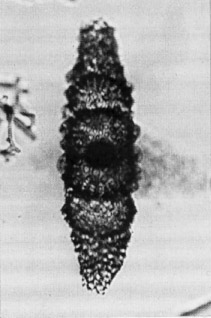 Didymocyrtis
penultima (Riedel)
Didymocyrtis
penultima (Riedel) Didymocyrtis
penultima (Riedel)
Didymocyrtis
penultima (Riedel)Panarium penultimum Riedel, 1957, p.76, pl.1, fig.1; Riedel and Funnell, 1964, p.311
Ommatartus penultimus (Riedel) sensu stricto, Riedel and Sanfilippo, 1970, p.521
Didymocyrtis penultima (Riedel), Sanfilippo and Riedel, 1980, p.1010
Cortical twin-shell constricted equatorially, with circular to irregularly rounded pores: its surface bearing prominent, obtuse protuberances. Distal chambers hemispherical, as caps on either end of cortical twin-shell, their length usually 0.2-0.3 that of twin-shell, somewhat narrower than twin-shell. Each cap surmounted by a spongy tube or tongue-shaped column, of which the width is approximately half that of the maximum breadth of twin-shell, or less. Outer medullary shell lenticular, inner one spherical (Riedel, 1957).
. . . Restricted to those forms in which the polar caps are at least as large, and as well separated from the cortical shell, as those of the holotype (Riedel and Funnell, 1964).
The proportion of the height of the polar caps to length of cortical shell in the holotype is 0.25 (Westberg and Riedel, 1978).
Length of cortical twin-shell usually 100-120 µm; its maximum breadth 80-105 µm. Length of polar caps 25-40 µm, of spongy polar columns 25-80 µm (Riedel, 1957).
The equatorially constricted cortical shell has a tuberculate surface, and the polar caps (at least as large and well developed as those of the holotype) bear narrow spongy columns (Ommatartus penultimus in Riedel and Sanfilippo, 1978a).
D. penultima is distinguished from its ancestor, D. antepenultima, by its larger polar caps (ratio of the polar cap to cortical shell 0.25 or greater). It is distinguished from its descendant, D. avita, by the presence of spongy columns. The multi-capped form is distinguished from D. hughesi by its equatorially constricted cortical shell and presence of spongy columns (Sanfilippo et al., 1985).
The tuberculate, equatoria1ly constricted, cortical shell bears at each end a polar cap that is 0.25 or more times the length of the cortical shell, and a spongy column.
In the upper part of the range (Stichocorys peregrina Zone - Spongaster pentas Zone), many specimens have multiple polar caps. In the early part of the range, when the caps are multiple, the second one is very small. Though the species has been defined as having narrow spongy columns, the bases of the columns in some specimens are as much as 0.8 the width of the polar caps. In well preserved samples, a veil sometimes surrounds the entire skeleton or sometimes only the cortical shell and caps (Sanfilippo et al., 1985).
D. penultima is found in sediments of late late Miocene to early Pliocene ages from latitudes lower than 40°. Its evolutionary transition from Didymocyrtis antepenultima is approximately synchronous with the lower limit of the Didymocyrtis penultima Zone and its evolutionary transition to Didymocyrtis avita lies within the Spongaster pentas Zone.
This species arose from D. antepenultima and evolved into D. avita.
Additional illustrations can be found in Westberg and Riedel, 1978, pl.2, figs.6-8.